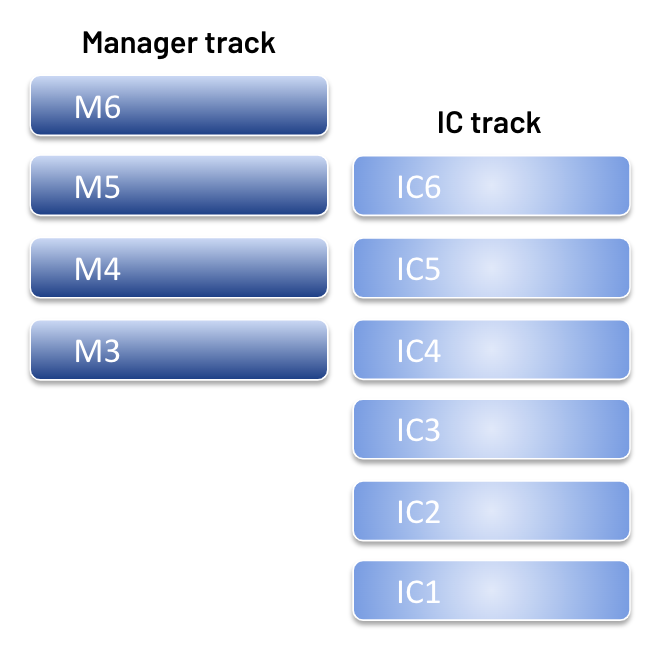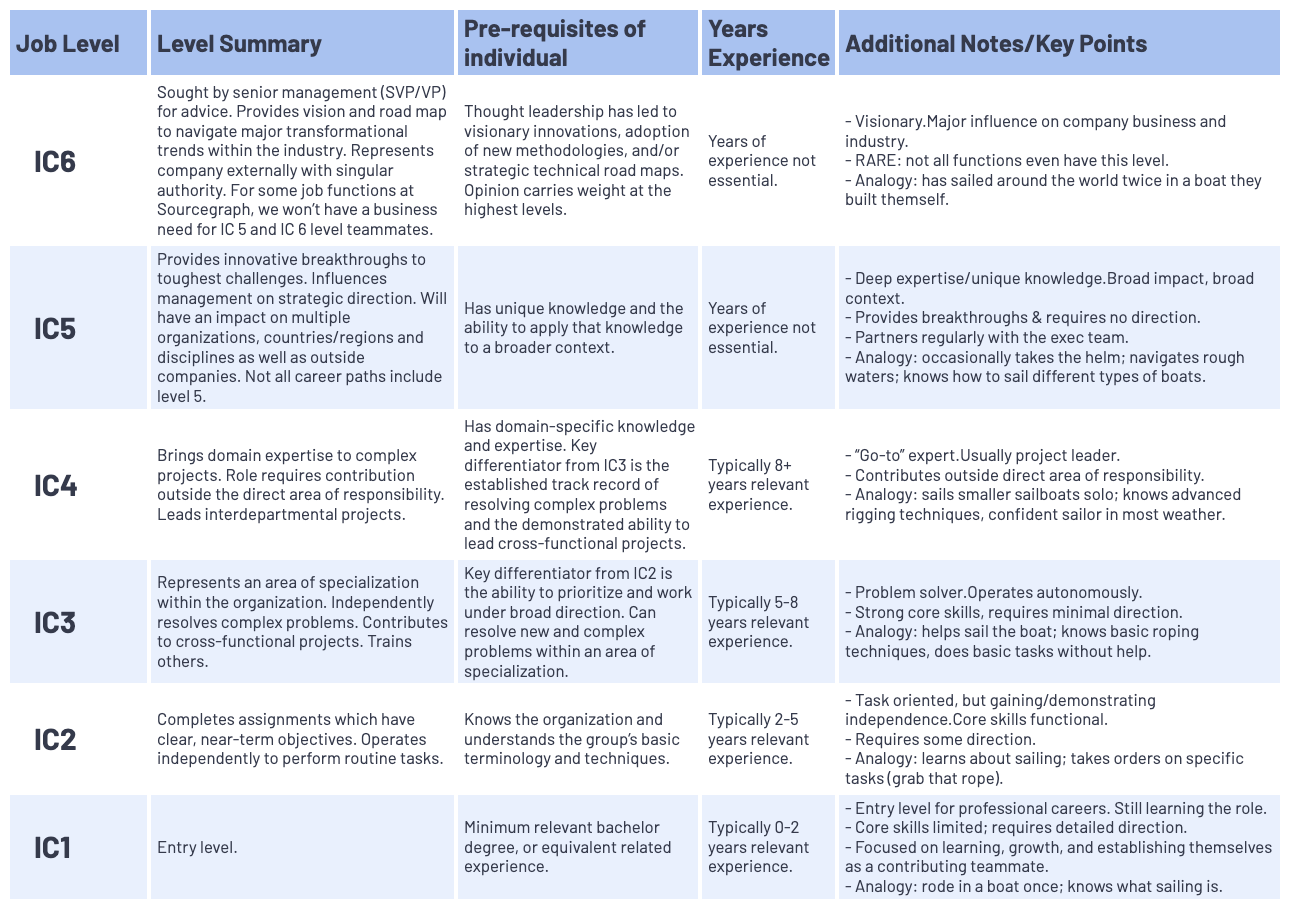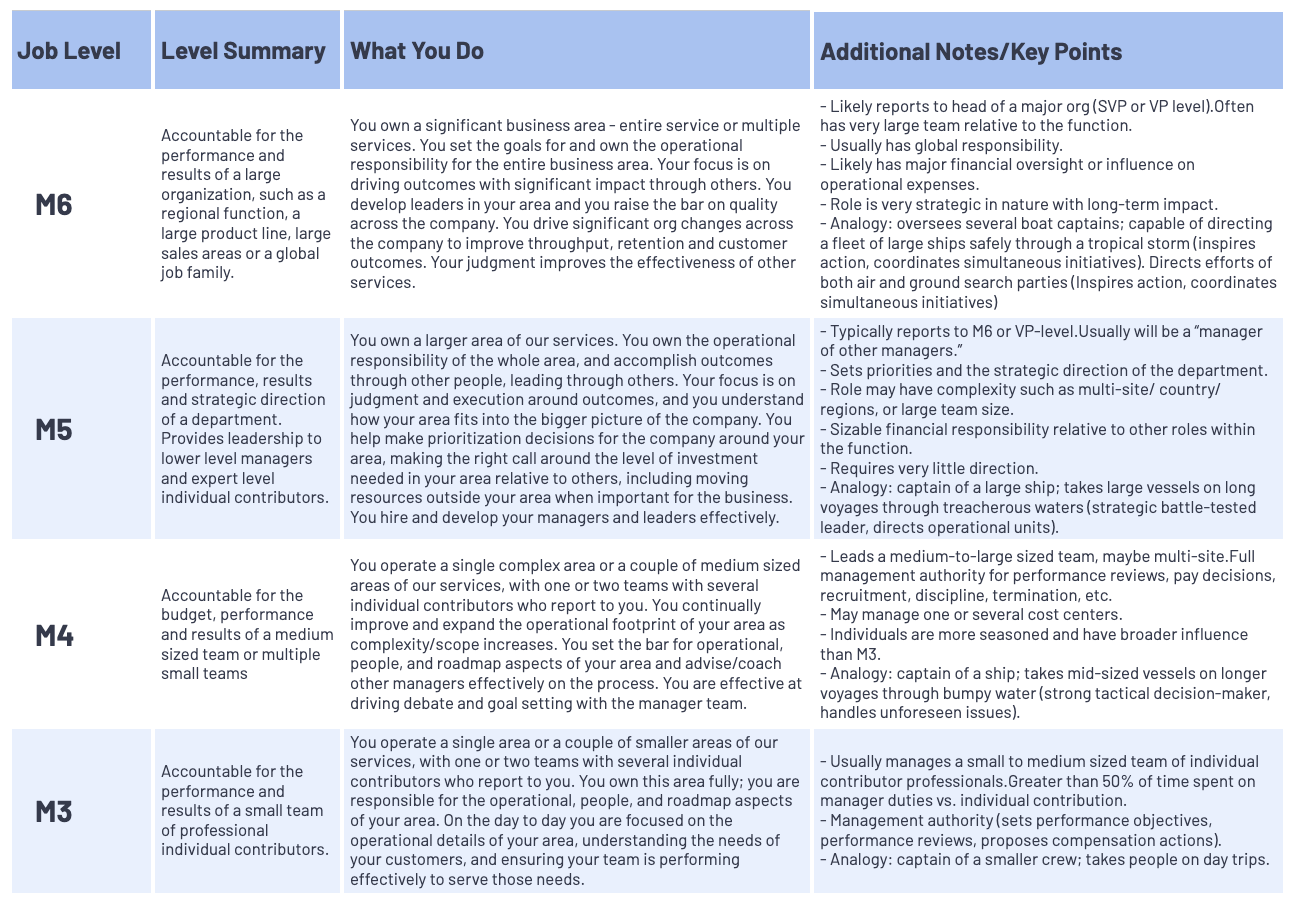Job levels at Sourcegraph
Job levels explained
Job levels and compensation bands are the building blocks of a strong compensation strategy. Together, they help ensure pay equity, improve recruiting and retention efforts, and help us build a more transparent company culture.
Job levels, also known as job grades and classifications, help us define the responsibility level and expectations of each role. Each level is defined by impact, seniority, knowledge, skills, and job title, and are associated with a specific pay band. Job levels ultimately help us make more strategic and consistent decisions around how we hire, engage, promote, and retain Teammates.
How do we use levels?
Levels are used to define career progression for individuals within a role, and are also a tool we use when benchmarking roles against salary survey data. This is how we price jobs and ensure market competitive compensation. We also use levels to discuss career progression and development. For example, we generally expect that an IC4 in one department has about the same level of responsibility and scope as an IC4 in another, in a general sense.
What levels do we use?
We divide all job families into two tracks:
- Individual Contributors
- The Individual track goes from IC1 to IC6
- Managers
- The Manager track goes from M3 to M6
IC & Manager tracks do not directly map to each other (in other words, an IC6 is not equivalent to a M6).

Individual contributor leveling
There are 6-levels in the IC career path - IC1 to IC6:

Manager leveling
At Sourcegraph, we use levels M3 to M6:

Titles at Sourcegraph
Sourcegraph’s title structure guidance aims to provide greater clarity and consistency in roles and responsibilities. The goal is to ensure that both managers and ICs have titles that accurately reflect their scope and level.
Manager Titles
Manager titles are designed to reflect the level of managerial responsibility and focus area of an individual in a leadership role. To qualify as a people leader, the teammate either 1) has direct reports or 2) is actively hiring for open headcount and building a team.
Title nomenclature: [Seniority], [Focus Area] Example: Senior Manager, Marketing
- Seniority: This represents the level of managerial experience and responsibility and is based on the individual’s experience and scope in a managerial role.
- Focus Area: This indicates the specific area or department where the manager holds responsibilities, such as Marketing, Operations, Finance, etc.
Individual Contributor (IC) Titles
IC titles are designed to emphasize the individual’s seniority, focus area, and role within the organization. Teams can also use levels instead of titles in their respective Career Framework. We do not force a standardized IC title structure across all career frameworks. Generally, title structure for ICs will follow the format:
Title nomenclature: [Seniority] [Focus Area] [Role/Scope] Example: Senior Marketing Program Manager
- Seniority: This reflects the individual’s level of seniority within their role, which can include Junior, Senior, Principal, and other designations based on experience.
- Focus Area: This specifies the department or area in which the individual contributes, such as Marketing, Engineering, Sales, etc.
- Role/Scope: This denotes the specific role or function of the individual within their focus area, such as Specialist, Analyst, Engineer, etc.
Level FAQ
How can I see my role and level?
All teammates are assigned a role (e.g. “Software Engineer,” “Product Manager,” “Account Executive”) and level (e.g. IC1, IC2, IC3).
- The Role defines what you do
- The level defines the expectations, competencies, abilities, and compensation as you progress within that role
Role: you can see your role title in the “job” tab of your profile in Bamboo.
Level: you can see your level in the “job” tab of your profile in Bamboo. The last two digits of your Radford code, which is listed in your Bamboo profile, indicates your role (IC or Manager) and level.
- Example: HR.GLBP.P1 indicates a level 1 Individual Contributor; HR.GLBP.M4 indicates a level 4 Manager.
You can see corresponding compensation ranges to all levels in our pay transparency tool, Assemble.
How do you determine my level?
When a new role is opened, the Manager scopes the position and determines what exactly this new Teammate will do, how much experience they need to have. A level is then assigned to that role based on this information. We hire for specific levels based on business need, and evaluate candidates according to the role/level being hired. Career development frameworks help further define what role-specific knowledge, skills, and abilities are required at each level.
For many roles, we’re rolling out career development frameworks for the first time. Managers are working closely with the People Team, leadership, and their immediate management teams to craft these frameworks. As you progress in your career, your role will be evaluated against the framework and leveled accordingly.
How does my level change over time?
A Teammate’s level can change as they progress in their career.
Each Teammate can see their expected career path by referencing their role-respective Career development frameworks. These frameworks will continue to evolve over time and should not be viewed as an exhaustive list of requirements - rather a basis from which enriching performance and development discussions evolve.
Our leveling guide and career development frameworks are the building blocks that drive career growth and development. They are used to bring consistency and transparency to expectations and promotion criteria/decisions across roles, levels, and teams.
How does my level impact compensation?
Every role and level combination corresponds to a pay band that informs compensation.
- Pay bands outline a range in which we expect each role at Sourcegraph to be paid. Pay bands inevitably shift with the market over time, and may be adjusted in response to the job market. We couple pay bands with both levels and job families to articulate expected salary for each role at Sourcegraph.
- We’ve aligned our levels to match levels in our compensation survey tool, Radford. This allows us to quickly “match” jobs to salary survey data and pull up-to-date market pay rate information. We began using Radford in and it is considered the best-of-the-best compensation and leveling tool that most high-growth SaaS companies use, as well.
- We regularly re-evaluate our pay bands to ensure market competitiveness. Our handbook page on compensation describes this process in greater detail.
Can I receive a compensation raise without changing levels?
- Yes, there are numerous ways to build skills and experience, which will ultimately lead you to making progress within a level’s dimensions. We complete a biannual talent review and compensation calibration, which includes reviewing and rewarding growth in level.
- We also benchmark our roles every 6 months to ensure we are keeping up with the market, and will make market adjustments as necessary when our bands are updated.
How do I progress from one level to the next?
- Promotions from one level to the next are considered in our biannual Talent Review process. Individuals striving toward, and meeting the expectations of, the next level are considered for promotion.
- To change an existing Teammate’s level, or do a promotion off-cycle, please alert your People Partner. They will then guide you through the promotion process to solidify the change.
How do we use levels in the recruiting process (for both internal and external candidates)?
- Prior to opening a requisition, headcount and leveling are calibrated based on the needs of the business and budget parameters. All levels are approved by Finance and VP of Talent & People/Board.
- Recruiters use the leveling framework to qualify role alignment and benchmark the candidate’s compensation expectations accordingly. The Hiring Team will calibrate leveling through the interview process and assessment.
- The Hiring Team will be informed of the candidate’s level in advance of the interview. Interviewers will assess the candidate according to the scorecard rubric associated with the respective level.
- Upon the completion of an interview process, the recruiter and hiring team will finalize the hiring decision and validate leveling prior to extending an offer.
- If there is misalignment between the candidate in consideration and the predefined scope of the role, the hiring manager will be required to re-calibrate role requirements and complete the approval process before finalizing the hiring decision:
- Candidate level is higher than the benchmark of the role they are being evaluated for: The Hiring Manager will need to submit an approval request to validate that the budget can be adjusted and that the hiring decision can be justified. The Recruiter will request a write-up for an offer justification to be provided by the Hiring Manager. This will be documented in Greenhouse, given the scope of the role has been upgraded.
- Candidate level is lower than the benchmark of the role they are being evaluated for: The Recruiter will request a write-up for an offer justification to be provided by the Hiring Manager. This will be documented in Greenhouse, given the scope of the role has been downgraded.
How do we use levels in the offer process (for both internal and external candidates)?
-
Levels are used in the offer process to ensure that the candidate’s compensation expectations are within band and that our current team is being compensated at market rate for their role and level.
-
Prior to extending an offer, the hiring team will qualify the level of the candidate and benchmark compensation expectations accordingly. Given our methodology to ensure pay parity for all teammates at the same level, we do not engage in negotiations outside of the pre-defined compensation range of the associated level. Note that teammates may be at different positions within a band - either when they join or are promoted, or as and when Talent Review adjustments are awarded. This is to be expected in all organizations and does not deviate from our pay parity principles.
- We typically review salary bands against market data twice per year. If market data indicates that our bands are inconsistent or below-market, we adjust the band.
- If the new compensation band is approved, adjustments will be made for all new hires and existing teammates.
Why are Sourcegraph’s levels different from other companies?
Every company has their own leveling system that is unique to their needs. This means that a Manager 3 at Sourcegraph, for example, is not necessarily equivalent to a level 3 Manager at another company. We design our leveling system based on Radford’s leveling guidelines.
-
Common offer calibration scenarios:
- Interview Execution vs Level Benchmark: Candidate interview assessment should be evaluated according to expectations of the job responsibilities and leveling benchmark. If a candidate performs at the expected level of an L3, but the qualified level was benchmarked at L4, the recommendation would be to not hire the candidate if they underperform in the interview assessment. In some cases, it may be appropriate for the hiring team to work with their recruiter to reset the candidate’s expectations, based on the functional role and development opportunities.
- Interview Execution vs Years of Experience: Candidate leveling should not be benchmarked exclusively to the candidate’s resume. For example, if a candidate interview assessment qualifies that they operate at the expected level of an IC5, but their total experience may align closer to others that are benchmarked at lower level, the hiring team should benchmark the candidate at the level we expect them to operate at, not based on the total years of experience within a specific function.